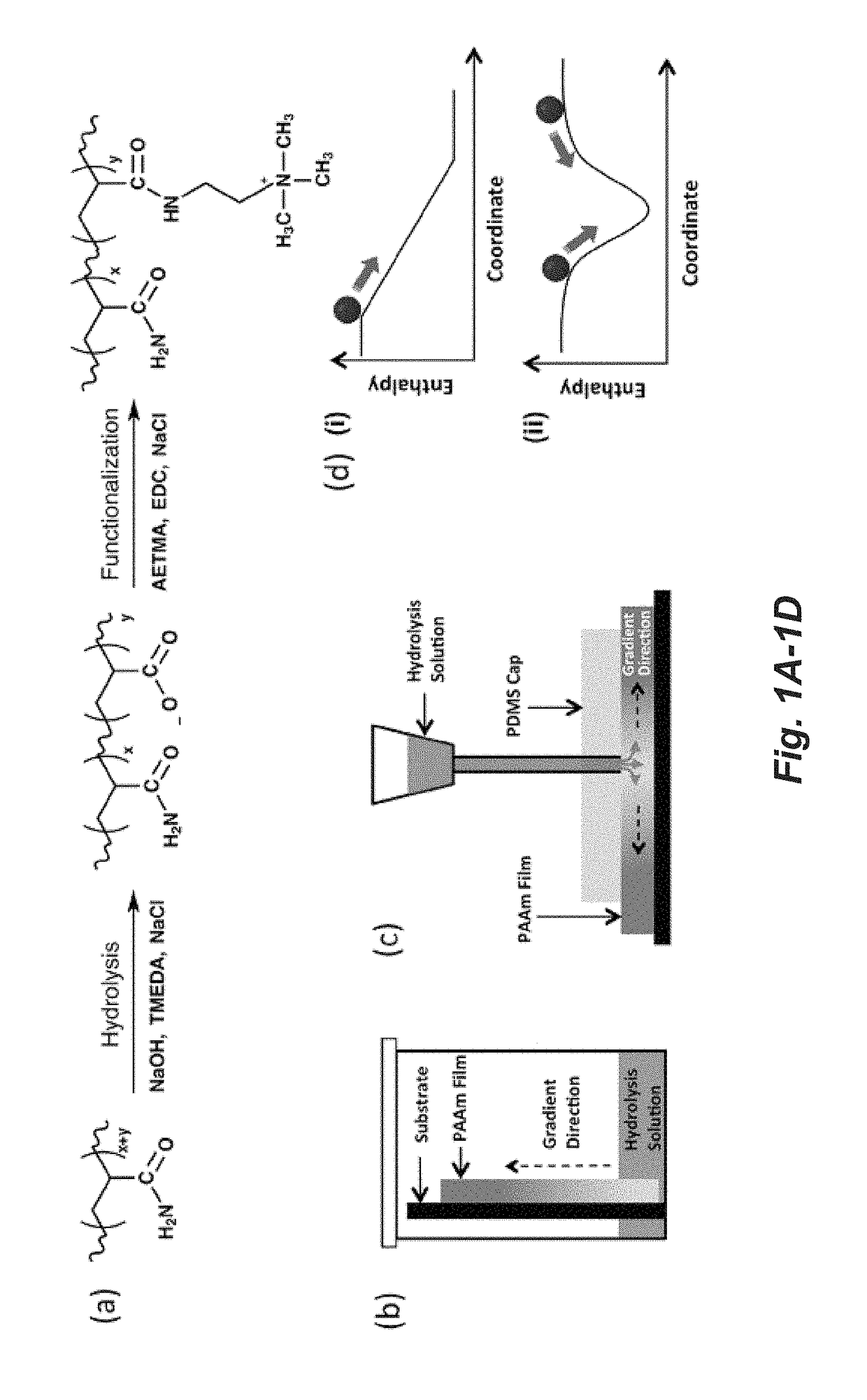Potential gradient amplified detection of chemical agents
a detection method and potentiometer technology, applied in biochemistry apparatus and processes, instruments, enzymology, etc., can solve the problems of delayed treatment, permanent damage to the nervous system, and non-lethal doses of permanent damage,
- Summary
- Abstract
- Description
- Claims
- Application Information
AI Technical Summary
Benefits of technology
Problems solved by technology
Method used
Image
Examples
example 1
Example 1
Materials and Methods
[0110]Reagents 3-(trimethoxysilyl)propyl methacrylate (≥98%), trichloro(1H,1H,2H,2H-perfluorooctyl)silane (97%), acrylamide / N,N′-methylenebisacrylamide mixture (AAm / BisAAm mixture, 37:1 weight ratio), N,N,N′,N′-tetramethylethylenediamine (99%), sodium hydroxide, sodium chloride, sodium nitrate, N-(3-dimethylaminopropyl)-N′-ethylcarbodiimide hydrochloride (EDC), sulfanilic acid sodium salt hydrate, (2-aminoethyl)trimethylammonium chloride hydrochloride (AETMA), bromothymol blue solution (dye content 95%), N,N′-dimethyl-9,9′-biacridinium dinitrate, and tetraethyl orthosilicate (TEOS), diethyl chlorophosphate, ethyl acetate purchased from Sigma Aldrich. 2,2-diethoxyacetophenone (DEAP, 98%) and dimethyl sulfoxide (DMSO) and Sylgard® 184 were purchased from Alfa Aesar.
Synthesis of PAAm Hydrogel Films
[0111]0.30 g of a 37:1 ratio mixture of AAm and BisAAm, was dissolved in 5.0 g Millipore water and the resulting monomer solution was shaken for 5 min using a Vo...
example 2
Example 2
Polymer Gel Comprising an Enzyme Catalyst for Trace Level Detection of an Analyte
[0113]Highly toxic chemical warfare agents (CWAs) such as sarin and related compounds are highly toxic even at trace concentrations. Disclosed herein is a chemical force-based signal amplification method to detect airborne sarin as low as tier-1 (6.90×10−09 mg / cm3 for 10 min) Acute Exposure Guideline Levels (AEGLs). As a proof of concept, detection of trace levels of an aerosol deposited sarin simulant, diisopropyl fluorophosphate (DFP) is demonstrated. The DFP is deposited on a hydrogel film and subsequently hydrolyzes upon contact with imbedded enzyme, diisopropyl fluorophosphatase (DFPase), producing P. The F− is then concentrated via a built-in ionic chemical gradient to a miniature electrochemical sensor. The net effect is a 30-fold amplification of the signal relative to a gradient-free system. This method is general for agents which hydrolyze into chemically detectable ionic species.
[011...
PUM
| Property | Measurement | Unit |
|---|---|---|
| pH | aaaaa | aaaaa |
| distance | aaaaa | aaaaa |
| distance | aaaaa | aaaaa |
Abstract
Description
Claims
Application Information
 Login to View More
Login to View More - R&D
- Intellectual Property
- Life Sciences
- Materials
- Tech Scout
- Unparalleled Data Quality
- Higher Quality Content
- 60% Fewer Hallucinations
Browse by: Latest US Patents, China's latest patents, Technical Efficacy Thesaurus, Application Domain, Technology Topic, Popular Technical Reports.
© 2025 PatSnap. All rights reserved.Legal|Privacy policy|Modern Slavery Act Transparency Statement|Sitemap|About US| Contact US: help@patsnap.com



